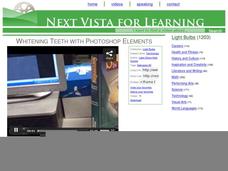Get Chemistry Help
Chemistry Lesson: Significant Digits and Rounding
Here's a riddle for you: You cannot see me, but I can change your answer. What am I? The first insignificant digit when rounding. This brief video provides a great explanation and guided example problems for practicing combining rounding...
Socratica
pH of 10 Common Household Liquids
Acids and bases are a part of our daily lives! Curious chemists explore the pH of such solutions as shampoo, sriracha, and glass cleaner through a video from Socratica's Chemistry Lessons series. The narrator predicts what she thinks the...
TED-Ed
How Close Are We to Uploading Our Minds?
What would it take to digitally upload someone's mind? A fascinating video first describes how a brain works, then looks at a future where people can live forever through avatars. The video describes the required technological advances...
Curated OER
What is a Terminating Decimal?
What is a decimal number called if it ends and has a finite number of digits? It's called a terminating decimal. Not all fractions are terminating decimals, but all terminating decimals can be written as fractions. Watch this video and...
Crash Course
Media Policy and You: Crash Course Media Literacy #9
Sharing is caring! How much does your class know about the laws that govern sharing on social media and other areas of the Internet? The video, part of an ongoing series about media literacy, examines copyright laws, intellectual...
Be Smart
How Does A Canyon Become Grand?
Ah, the Grand Canyon ... ain't it grand? The narrator of a video from PBS Digital Studios explains, in detail, how the Grand Canyon was formed over millions of years.
Curated Video
Copyright
Introduce your class to the concept of copyright with a series of activities. Pupils first learn about copyright laws and fair use, putting their knowledge to the test with a quick categorizing task. They then watch a video and answer...
Curated OER
Comparing Large Numbers
Here is a great real life example of when a person would need to compare numbers. Each of the four examples explains how to compare the numbers beginning with the number at the left and compare the value of each digit. The examples begin...
Curated OER
How Do You Check if a Number is Divisible by 2, 3, 5, 6, and 10?
How will learning about the divisibility rules help you do better in math? Well, if you have multi-digit numbers to factor, these rules will definitely help you factor numbers more quickly.
Curated OER
How Do You Do Long Multiplication?
Multiplying multi-digit numbers without a calculator. First, make sure you align the numbers properly. It's not just about multiplying, but there's carrying numbers and adding numbers and placeholders. You can do it, just remember to...
TED-Ed
The Demise of Guys
Girls are outperforming boys at all levels from elementary to graduate school. Psychologist Philip Zimardo considers the reasons why boys are struggling today, including the possible effects of excessive Internet use and the idea that...
TED-Ed
Network Theory
In some ways, the digital world is a living, evolving organism. Take a look at a popular theory that helps to explain some big questions about connections. The video defines networks, power functions, nodes and hubs, and includes an...
Nemours KidsHealth
How the Body Works—Nails
Be warned that a giant finger emerges from the ground as a model that Chloe uses to teach Nurb about nails. The digit imagery may not be appropriate for your class, depending on their level of maturity. You might want to pass on the...
Curated OER
Enzymes, Proteins, Carbohydrates, Digestion
Did you know that different types of food are digested in different parts of the body? Proteins are primarily digested in the stomach, fats in the small intestine, and carbohydrates begin to break down in the mouth. This highly...
Curated OER
How a Car Engine Works
The different parts of a car engine digitally come together to assemble the engine in its totality. Once assembled, the machine moves to show internal combustion. Music plays, but no explanation or narration is given. Show to your...
Curated OER
Whitening Teeth with Photoshop Elements
Learn how to digitally whiten teeth with this tutorial video. This tutorial uses Adobe Photoshop Elements.
Curated OER
How Do You Do Long Multiplication?
Multiplying multi-digit numbers without a calculator. First, make sure you align the numbers properly. It's not just about multiplying, there's carrying numbers and adding numbers and placeholders. You can do it, just remember to line up...
Scholastic
Study Jams! Divisibility Rules
Learning division is a challenge for many young mathematicians, but this presentation on divisibility rules can make it much easier. Seven different rules are clearly explained and modeled with the support of multiple examples. Consider...
TED-Ed
How Computer Memory Works
Just how does computer memory work? Really, it's all zeros and ones. Learn more about bits, binary digits, memory cells, memory latency, and CPS in a short video about how computer memory works.
Alison Neibling
Introduction to Poetry: The 3 R's
Get to the know the importance of the three R's of poetry (rhyme, repetition, and rhythm) with this video created to accompany your poetry instruction for a middle school audience. With detailed information, examples, and digital...
Be Smart
Whose Air Do You Share?
Take a deep breath before watching this video from PBS Digital Studios that models for viewers how humans are connected through the air we share. The video explores how small the earth's atmosphere is compared to the rest of Earth.
Be Smart
Why Does the Wind Blow?
When you tell people you know why the wind blows, it won't be a bunch of hot air. In the video from PBS Digital Studios, viewers learn how wind is a consequence of differences in air pressure. Along the way, the video covers the Coriolis...
Be Smart
How Many Trees Are There?
Yew'll be amazed at how many trees there are on Earth. PBS Digital Studios model for viewers how the answer to the title question was determined using satellite information. Along the way, learners will encounter a myriad of statistics...
Be Smart
100,000,000 Years From Now
Holocene, Pleistocene, Pliocene, Miocene, Oligocene, Eocene, Paleocene ... wait, did I miss one? PBS Digital Studios explains how human impact on Earth has potentially brought about a new epoch in geologic history, the Anthropocene....
Other popular searches
- Digital Storytelling
- Digital Photography
- Digital Clock
- Digital Media
- Digital Imaging
- Digital Art
- Digital Microscope
- Digital Video Camera
- Digital Self Portraits
- Digital and Analog Clocks
- Netiquette
- Digital Cameras

























